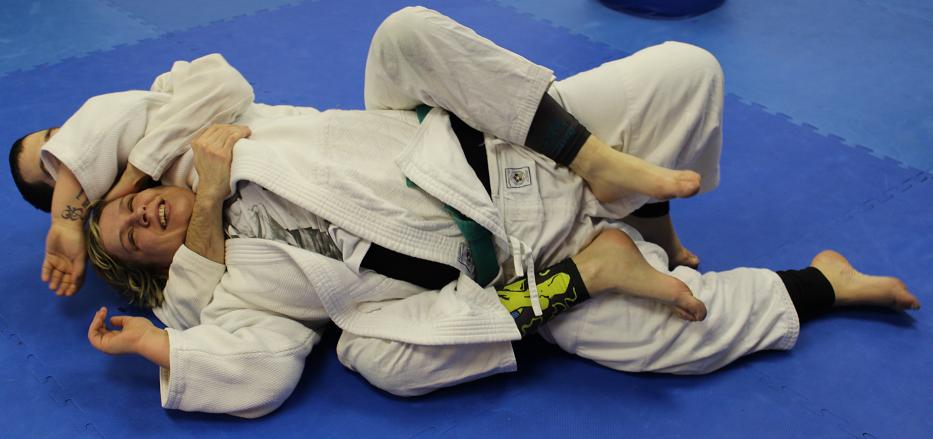Bristol Sports Centre (Artemis BJJ), Can Sönmez, Bristol, UK - 09/04/2014
The GrappleThon is THIS WEEKEND! Our press release can be found here, with links to all the details. :D
It all starts at 2pm this Saturday at the new Hit Fit venue, which isn't open for business yet but they are kindly letting us use it for the GrappleThon. I'll be gathering my cereal bars and GrappleThon paraphernalia on Friday night, ready for another twenty-four hours of feeling very tired but making new friends and raising money for a great cause. We're already well over £4,000, which is brilliant!
____________
 We're moving on to a new position of the month, which for April will be the back. The back is a great position to be in. There are lots of submissions, your opponent can't easily see what you're doing, and you'll also get four points in competition (once you've got your hooks in). The first thing to note is a basic safety point, which is don't cross your feet. If you cross your feet, then all your partner has to do is cross their feet over yours and bridge, footlocking you. Instead, you want to be hooking your insteps inside their legs.
We're moving on to a new position of the month, which for April will be the back. The back is a great position to be in. There are lots of submissions, your opponent can't easily see what you're doing, and you'll also get four points in competition (once you've got your hooks in). The first thing to note is a basic safety point, which is don't cross your feet. If you cross your feet, then all your partner has to do is cross their feet over yours and bridge, footlocking you. Instead, you want to be hooking your insteps inside their legs.Second, you want to get a good grip with your arms. The harness grip (as always, various other names, like over-under) is a solid option for both gi and nogi. Begin by getting an arm under their same side armpit, so they can't slide down (as otherwise they can go for the escape I taught last week). If they have a gi, you can help secure the position by grabbing their opposite collar. The other arm comes over their shoulder.
If you can't grab a collar, then link your hands together, using that to lock yourself in place. You could also grab under both arms grabbing a collar, which is a excellent way to hold them in place. However, that means both your arms are occupied: for attacks, you have more options if you keep one arm free, to go over the shoulder.
Your arm by the shoulder is the one you'll be looking to shift into their neck and/or grabbing a collar, where you can start working for a choke. Stephan Kesting advises that rather than linking hands, you can grab your own arm, which in turn means you are blocking the best grip your opponent wants to get. As ever, play around and see what you prefer.
Third, keep your chest pressed against their upper back. To escape, they need to create space, so don't let them have any: stay glued to their upper back. You also don't want them to put you flat on your back, like in the bridge escape we saw last week, as then they can start moving their hips. If you drop back, make sure you've moved to the side. However, your ideal position is getting them face down.
Fourth, follow them with your hips, similar as when you're in their guard. If you keep moving your hips to square back up whenever they try and shift away, that again stops them creating space.
Finally, you want to keep your head locked to theirs, providing additional control. It also helps you to see what they're doing. Otherwise, their head would be blocking your line of sight. Place your head next to theirs on the armpit hand side, as that way you're controlling both sides of their skull.
_____________________
Teaching Notes: It was all blue belts tonight, so I'm not sure if my typical lesson was a bit basic. As a result, I threw in some additional details, drawing from the recent private with Kev (that 'straitjacket' grip on the lockdown type thing from the back), along with the Marcelo Garcia 'hip extension' for getting your second hook in. I'm also not sure if it's worth including the bit on following them with your hips. Perhaps I should add the hip extension detail to this lesson? Probably wouldn't take too much additional time, but it doesn't quite fit with the current "here are the basics of maintaining the back" format.
How complex to make a lesson is an ongoing question. On the one hand, I think it's really important to nail down the fundamentals and that you are never 'too good' to spend a bit more time working on those basics. On the other hand, jiu jitsu should be fun, so I don't want people to get bored thinking they've seen this already. That balance between fun and useful is something I'll be considering a lot in the coming months: it's handy that I know Dónal is there to teach the other lessons each week, as he's very good on both. ;)
No comments:
Post a Comment